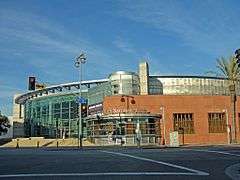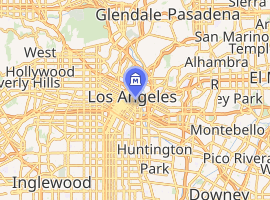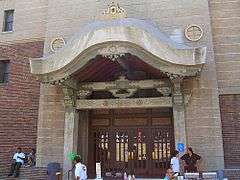Japanese American National Museum
The Japanese American National Museum (全米日系人博物館, Zenbei Nikkeijin Hakubutsukan) is located in Los Angeles, California, and dedicated to preserving the history and culture of Japanese Americans. Founded in 1992, it is located in the Little Tokyo area near downtown. The museum is an affiliate within the Smithsonian Affiliations program.[1]
 Museum at First Street | |

| |
| Established | 1992 |
|---|---|
| Location | Little Tokyo, Los Angeles, California |
| Type | History and culture of Japanese Americans |
| Public transit access | |
| Website | www.janm.org |

The museum covers more than 130 years of Japanese-American history, dating to the first Issei generation of immigrants. Its moving image archive contains over 100,000 feet (30,000 m) of 16 mm and 8 mm home movies made by and about Japanese Americans from the 1920s to the 1950s. It also contains artifacts, textiles, art, photographs, and oral histories of Japanese Americans. The Japanese American National Museum of Los Angeles and the Academy Film Archive collaborate to care for and provide access to home movies that document the Japanese-American experience. Established in 1992, the JANM Collection at the Academy Film Archive currently contains over 250 home movies and continues to grow.[2]
History
Activist Bruce Kaji and other notable Japanese-American individuals conceived of the idea of the museum. The community had become organized around gaining recognition of the injustice they had suffered from the federal government during World War II.
The museum was conceived as a way to preserve the positive aspects of their full history and culture in the United States. When it first opened in 1992, the museum was housed in the 1925 historic Hompa Hongwanji Buddhist Temple building. Irene Hirano served as its first executive director and later as president and CEO of the museum.[3] In January 1999, the National Museum opened its current 85,000-square-foot (7,900 m2) Pavilion, designed under the supervision of architect Gyo Obata, to the public.[4] The temple building was used by government officials in 1942 to process Japanese Americans for wartime confinement. It is now used for offices and storage.
In 1993 the museum was given hundreds of artifacts and letters from children in internment camps, which they had sent to San Diego librarian Clara Breed. The material was featured in an exhibit, "Dear Miss Breed": Letters from Camp. It is now part of the museum's permanent collection.[5]
In 1997, the Frank H. Watase Media Arts Center was established by Robert A. Nakamura and Karen L. Ishizuka, to develop new ways to document, preserve and make known the experience of Americans of Japanese ancestry. In 1999, the Manabi and Sumi Hirasaki National Resource Center (HNRC) was established to provide access to the museum's information and resources, both at the facility and online. It documents the life and culture of the Japanese Americans.
Akemi Kikumura Yano, author,[6] was the museum's first curator. She succeeded Irene Hirano as President and CEO from 2008 until 2011. During her tenure, on December 2010, the museum was awarded the National Medal for Museum and Library Service.[7]
Rev. Greg Kimura, an Episcopal priest, was appointed the president and CEO of the museum, serving between 2012 and 2016.[8][9][10] During his time the museum experienced an economic downturn as he looked to promote untraditional exhibits and let go core staff members. He resigned in May 2016 to pursue other work opportunities.[11]
In 2016, Ann Burroughs was announced to replace him as the new interim CEO[12] and was officially selected shortly thereafter. Burroughs spoke of her role: "I am committed to reinvigorating and finding new ways to advance the museum’s key values, emphasizing the importance of being vigilant about democracy and stressing the value of diversity in our world today."[13]
Actor George Takei serves as a member of the museum's board of trustees. He represented it as his charity during his time on The Celebrity Apprentice and during his appearance on The Newlywed Game.[14]
Exhibits
The museum's current longterm exhibition is Common Ground: The Heart of Community, covering 130 years of Japanese American history, from the Issei and early immigration into the United States, World War II incarceration, to the present.[15]
Selected previous exhibitions
- Hello! Exploring the Supercute World of Hello Kitty (October 11, 2014 - May 31, 2015)[16]
- Dodgers: Brotherhood of the Game (March 29 - September 14, 2014)[17][18]
- Perseverance: Japanese Tattoo Tradition in a Modern World (March 8 - September 14, 2014)[19]
- Marvels & Monsters: Unmasking Asian Images in U.S. Comics, 1942-1986 (October 12, 2013 - February 9, 2014)[20]
- Folding Paper: The Infinite Possibilities of Origami (March 10 - August 26, 2012)[21]
- Drawing the Line: Japanese American Art, Design & Activism in Post-War Los Angeles (October 15, 2011 – February 19, 2012)[22][23]
- Year of the Rabbit: Stan Sakai's Usagi Yojimbo (July 9 - October 30, 2011)[24]
- No Victory Ever Stays Won: The ACLU's 90 Years of Protecting Liberty (November 21 - December 11, 2010)
- Mixed: Portraits of Multiracial Kids by Kip Fulbeck (March 20 - October 17, 2010)[25]
- 20 Years Ago Today: Supporting Visual Artists in L.A. (October 4, 2008 - January 11, 2009)[26]
- Glorious Excess (Born): Paintings by Linkin Park's Mike Shinoda (July 12 - August 3, 2008)[27]
- Living Flowers: Ikebana and Contemporary Art (June 15 - September 7, 2008)[28]
- Southern California Gardeners' Federation: Fifty Years (October 25 - November 13, 2005)[29]
- Boyle Heights: The Power of Place (September 8, 2002 – February 23, 2003)[30]
- Sumo U.S.A.: Wrestling the Grand Tradition (July 3 - November 30, 1997)[31]
- Dear Miss Breed: Letters from Camp (January 14 - April 13, 1997)[32]
Major projects
Discover Nikkei A multilingual, online resource that presents the global Nikkei experience through first-person narratives, historic photos and research, and opportunities for user engagement.
The museum's International Nikkei Research Project produced the book New Worlds, New Lives.
Additional images
See also
References
- "Japanese American National Museum". Affiliate detail. Smithsonian Affiliations. 2007. Archived from the original on 29 September 2011. Retrieved 17 Jul 2011.
- "Japanese American National Museum Collection". Academy Film Archive.
- Yamato, Sharon. "Japanese American National Museum". Densho Encyclopedia. Retrieved 30 October 2014.
- Patt Morrison, Cecilia Rasmussen, Angels Walk – Union Station, El Pueblo, Little Tokyo, Civic Center, Angels Walk LA, Inc., 2000
- "Dear Miss Breed: Letters from Camp". Japanese American National Museum. Retrieved 28 February 2014.
- "Kikumura-Yano, Akemi 1944- [WorldCat Identities]". Retrieved Sep 12, 2019.
- "AKEMI KIKUMURA YANO DECIDES TO STEP DOWN AS PRESIDENT/CEO OF JAPANESE AMERICAN NATIONAL MUSEUM | Press Releases | Japanese American National Museum". www.janm.org. Retrieved Sep 12, 2019.
- "Alaska priest appointed as CEO of Japanese American museum". Retrieved Sep 12, 2019.
- Watanabe, Teresa (2012-01-21). "Japanese American National museum hires CEO". Los Angeles Times. Retrieved 2014-05-10.
- Guzmán, Richard (2012-09-25). "New CEO Shakes Up Japanese American National Museum". LA Downtown News. Retrieved 2014-05-10.
- "APAs in the News," Pacific Citizen, June 3–16, 2016, p. 4.
- "JANM ANNOUNCES INTERIM PRESIDENT/CEO | Press Releases | Japanese American National Museum". www.janm.org. Retrieved Sep 12, 2019.
- Regardie, Jon. "JANM Names New Leader". Los Angeles Downtown News - The Voice of Downtown Los Angeles. Retrieved Sep 12, 2019.
- "A Day in Gay America". Advocate. November 2011. p. 25.
- "Common Ground: The Heart of Community". Japanese American National Museum. Retrieved 2014-05-10.
- "Not just cute and not a cat: Hello Kitty's first museum retrospective". Los Angeles Times. 2014-10-09. Retrieved 2015-04-23.
- "Baseball Theme at JANM's Target Free Family Saturday". Rafu Shimpo. 2014-05-09. Retrieved 2014-05-10.
- "Dodgers: Brotherhood of the Game at JANM; Plus Perseverance and Mike Kelley". Imprint Culture Lab. 2014-04-01. Archived from the original on 2014-05-12. Retrieved 2014-05-10.
- Mitchell, Jon (2014-03-04). "Loved abroad, hated at home: the art of Japanese tattooing". The Japan Times. Retrieved 2014-05-10.
- "Marvels and Monsters: Unmasking Asian Images in U.S. Comics, 1942-1986". Angry Asian Man. 2011-05-19. Retrieved 2014-05-10.
- Mori, Darryl (2012-03-02). "Folding Paper: The Infinite Possibilities of Origami—An Interview with Curator Meher McArthur". Discover Nikkei. Retrieved 2014-05-10.
- Guzmán, Richard (2011-11-18). "JANM Exhibit Looks at the Contributions of Post-War Japanese American Artists". LA Downtown News. Retrieved 2014-05-10.
- "Drawing the Line: Japanese American Art, Design & Activism in Post-War Los Angeles". Discover Nikkei. 2012-01-20. Retrieved 2014-05-10.
- Babayan, Siran (2011-08-31). "Year of the Rabbit: Stan Sakai's Usagi Yojimbo". LA Weekly. Retrieved 2014-05-10.
- Namkung, Victoria (2014-04-19). ""Mixed: Portraits of Multiracial Kids" Exhibition in L.A." The Huffington Post. Retrieved 2014-05-10.
- "Adjunct Ruby Osorio in group exhibition 20 Years Ago Today at the Japanese American National Museum". USC Roski School of Art and Design. Retrieved 2014-05-10.
- Ruano, L. (2008-07-14). "Mike Shinoda | Glorious Excess (Born) Recap". Hypebeast. Retrieved 2014-05-10.
- Hodge, Brooke (2008-06-26). "Seeing Things | Flower Power". The New York Times Style Gazine. Retrieved 2014-05-10.
- Kraus, Victoria (2014-06-08). "half enough: The East L.A. Gardeners Association sign on First Street". Discover Nikkei. Retrieved 2014-05-10.
- "The Power of Place: Boyle Heights Project". Retrieved 2014-05-10.
- Komai, Chris (1997-07-01). "Sumo U.S.A.: Wrestling the Grand Tradition Opens at the Japanese American National Museum". Japanese American National Museum. Retrieved 2014-05-10.
- "Dear Miss Breed: Letters from Camp..." Japanese American National Museum. Retrieved 2014-05-10.
External links
| Wikimedia Commons has media related to Japanese American National Museum. |

